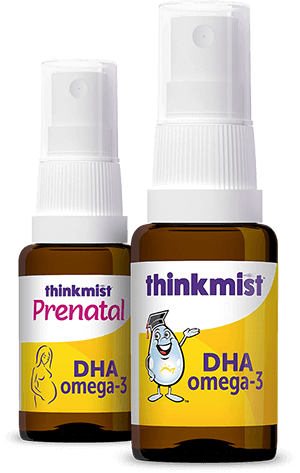Why DHA?
Why DHA?
DHA is an omega-3 fatty acid that supports the healthy growth and development of your child’s brain, eyes, and nervous system. It serves as an important building block and is commonly introduced during periods of rapid growth, such as during pregnancy, infancy, and childhood.
Where do I get DHA?
DHA is naturally found in certain foods, like oily or fatty fish. We know how important fish is as part of a healthy lifestyle, providing key nutrients and essential fatty acids that our bodies have limited ability to make on their own.
Few foods are naturally high in DHA and some, known as fortified foods, have omega-3s added to them. DHA is found almost exclusively in fish like sardines and anchovies, and in some enriched foods like eggs.
How much DHA do I need?
The answer depends on several factors, including your age, weight, and diet.
The World Association of Perinatal Medicine, along with other recognized health organizations, recommend 200 mg of DHA daily for pregnant and breastfeeding moms. After your baby is born, Health Canada recommends by 24 months of age, children have 2 servings of oily fish a week.
Getting enough DHA from food alone can be difficult. Research shows, on average, many of us are not meeting the recommended intake levels for seafood and could be missing key nutrients that play an important role in our overall health.

Thinkmist® and Thinkmist® Prenatal are available for those concerned about receiving enough DHA. View them here.
- "Omega-3 Supplements: In Depth." National Center for Complementary and Integrative Health, U.S. Department of Health and Human Services, 12 July 2016, Read more. Accessed 23 Aug. 2017.
- Nesheim, Malden C., and Ann L. Yaktine. Seafood choices balancing benefits and risks. Washington, D.C., National Academies Press, 2007. Read more.
- Consumers." GOED Omega-3s, Global Organization for EPA and DHA Omega-3s, Read more. Accessed Aug. 2017.b
- Office of Dietary Supplements - Omega-3 Fatty Acids." NIH Office of Dietary Supplements, U.S. Department of Health and Human Services, 2 Nov. 2016, Read more. Accessed Aug. 2017.
- U.S. Department of Health and Human Services and U.S. Department of Agriculture. 2015 - 2020 Dietary Guidelines for Americans. 8th Edition. December 2015. Available at Read more.
- Murphy, Rachel, et al. "Suboptimal Plasma Long-Chain n-3 Concentrations are Common among Adults in the United States, NHANES 2003-2004." Nutrients, vol. 7, no. 12, Sept. 2015, pp. 10282-10289., doi:10.3390/nu7125534
- Johnston M Landers S Noble L Szucs K and Viehmann L for the Section on Breastfeeding (2012). Breastfeeding and the use of human milk. Pediatrics 129:e827-e841. [online] Available at: Read more
- "Consumers." GOED Omega-3, Global Organization for EPA and DHA Omega-3s, Read more. Accessed Aug. 2017.
- Center for Food Safety and Applied Nutrition. "Consumers - Eating Fish: What Pregnant Women and Parents Should KNOW." U.S. Food and Drug Administration Home Page, Center for Food Safety and Applied Nutrition, Aug. 2017, Read more. Accessed Aug. 2017.







